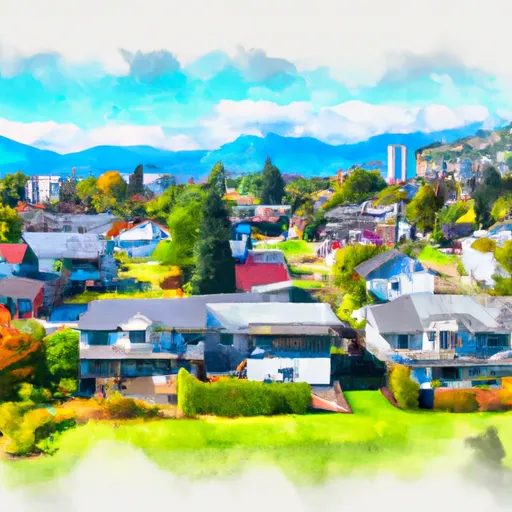-
 Snoflo Premium
Snoflo Premium
Get unlimited access to all our content
With no Ad interruptions! - Start Your Free Trial Login with existing account
Veradale
Eden Index
Climate
8.6
•
Recreation
3.1
•
Community
2.7
•
Safeguard
5.2/10

Veradale is a small community located in Spokane County, Washington. It experiences a temperate continental climate, characterized by warm summers and cold winters. Summers in Veradale are typically dry and sunny, with average temperatures ranging from the mid-70s to low 80s Fahrenheit. Winters are cold and snowy, with temperatures dropping below freezing, and snowfall occurring from November to February.
The hydrology of Veradale is influenced by the nearby Spokane River, which provides a scenic backdrop and recreational opportunities. The river supports a variety of aquatic life, including fish species like trout and salmon. Additionally, Veradale is surrounded by several lakes, including Liberty Lake and Newman Lake, which offer opportunities for boating, fishing, and swimming.
Outdoor recreation opportunities in Veradale are abundant. The region boasts numerous parks and trails, such as the Spokane River Centennial Trail, which provides an excellent route for hiking, biking, and walking along the river. The Dishman Hills Natural Area, located nearby, offers extensive trail systems for hiking, trail running, and wildlife viewing. Golf enthusiasts can enjoy the MeadowWood Golf Course, renowned for its beautiful setting and challenging layout.
In summary, Veradale, Washington, offers a pleasant climate with distinct seasons, a hydrology influenced by the Spokane River and surrounding lakes, and various outdoor recreation opportunities, from hiking and biking to golfing and water sports.
What is the Eden Index?
The Snoflo Eden Index serves as a comprehensive rating system for regions, evaluating their desirability through a holistic assessment of climate health, outdoor recreation opportunities, and natural disaster risk, acknowledging the profound impact of these factors on livability and well-being.
Climate Health Indicator (CHI): 8.6
Veradale receives approximately
502mm of rain per year,
with humidity levels near 74%
and air temperatures averaging around
9°C.
Veradale has a plant hardyness factor of
6, meaning
plants and agriculture in this region thrive during a short period during spring and early summer. Most
plants will die off during the colder winter months.
By considering the ideal temperature range, reliable water supplies, clean air, and stable seasonal rain or snowpacks, the Climate Health Indicator (CHI) underscores the significance of a healthy climate as the foundation for quality living.
A healthy climate is paramount for ensuring a high quality of life and livability in a region, fostering both physical well-being and environmental harmony. This can be characterized by ideal temperatures, reliable access to water supplies, clean air, and consistent seasonal rain or snowpacks.
Weather Forecast
Streamflow Conditions
Spokane
Area Rivers
Spokane
Snowpack Depths
Spokane
Reservoir Storage Capacity
Spokane
Groundwater Levels
Recreational Opportunity Index (ROI): 3.1
The Recreational Opportunity Index (ROI) recognizes the value of outdoor recreational options, such as parks, hiking trails, camping sites, and fishing spots, while acknowledging that climate plays a pivotal role in ensuring the comfort and consistency of these experiences.
Access to outdoor recreational opportunities, encompassing activities such as parks, hiking, camping, and fishing, is crucial for overall well-being, and the climate plays a pivotal role in enabling and enhancing these experiences, ensuring that individuals can engage in nature-based activities comfortably and consistently.
Camping Areas
| Campground | Campsites | Reservations | Toilets | Showers | Elevation |
|---|---|---|---|---|---|
| Mount Spokane State Park | 8 | 3,092 ft | |||
| Liberty Lake Regional Park | 22 | 2,098 ft |
Nearby Ski Areas
Catastrophe Safeguard Index (CSI):
The Catastrophe Safeguard Index (CSI) recognizes that natural disaster risk, encompassing floods, fires, hurricanes, and tornadoes, can drastically affect safety and the overall appeal of an area.
The level of natural disaster risk in a region significantly affects safety and the overall livability, with climate change amplifying these risks by potentially increasing the frequency and intensity of events like floods, fires, hurricanes, and tornadoes, thereby posing substantial challenges to community resilience and well-being.
Community Resilience Indicator (CRI): 2.7
The Community Resilience Indicator (CRI) recognizes that education, healthcare, and socioeconomics are crucial to the well-being of a region. The CRI acknowledges the profound impact of these elements on residents' overall quality of life. By evaluating educational resources, healthcare accessibility, and economic inclusivity, the index captures the essential aspects that contribute to a thriving community, fostering resident satisfaction, equity, and social cohesion.

